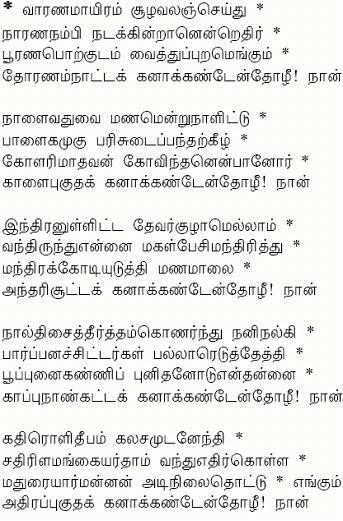Of Religious Poetry and Romance....
It’s been long since I “posted’ posted. Its 5 15 on Thursday, February 24, 2005. It’s a snowy evening; I am sitting on my bed, sipping on some the last few drops of “Tazo Chai” – outcome of a desperate visit to Starbucks with a Bitsian, in the aftermath of a splooshed test. (How we never move on!!!).
Sometime later: Its 12 00 now, just came back after watching “Bride and Prejudice” in Esquire on Ludlow. The movie? the less said the better. (*read as future post material!!*)
So anyway, few days back, a late night, I was listening to some really good music, and acting “Wedding Planner” for my roomie, when we began recollecting a few stanzas of "Karnamrutham". I am not a real great fan of poetry in general, so religious poetry does not hold too much significance for me either. I definitely wasn’t the “Thirupugazh” chanting types. My association with this genre of poetry almost exclusively had to do with my Carnatic music, and trying in vain to memorize those mandatory stanzas before an exam, much to the chagrin of my tenth standard Tamil teacher or my Twelfth standard Sanskrit Teacher.
Sometime later: Its 12 00 now, just came back after watching “Bride and Prejudice” in Esquire on Ludlow. The movie? the less said the better. (*read as future post material!!*)
So anyway, few days back, a late night, I was listening to some really good music, and acting “Wedding Planner” for my roomie, when we began recollecting a few stanzas of "Karnamrutham". I am not a real great fan of poetry in general, so religious poetry does not hold too much significance for me either. I definitely wasn’t the “Thirupugazh” chanting types. My association with this genre of poetry almost exclusively had to do with my Carnatic music, and trying in vain to memorize those mandatory stanzas before an exam, much to the chagrin of my tenth standard Tamil teacher or my Twelfth standard Sanskrit Teacher.
In India, religion is all encompassing. God, assumes many roles - a King,a child, a friend,a lover.Krishna, is widely picturised as a universal lover,romancing with his many Gopikas.(The philosophical explanation,being that the Lord is the paramathma, and all souls the Jeevathma.)So anyway, the more I thought about it, I was able to come up with a lot of such very good religious-romantic poetry stuff.Here are two such examples in point.
Non-Tamil readers, Sorry for the remainder of this post, but I just had to write this one!!!
Tamil religious poetry , has a lot of beautiful verses too.This peice, sung as a part of traditional marriage cermony in South India, was composed by Saint Andal,where she vividly picturizes getting married to Lord Vishnu. I must have heard it countless times,but I guess I never really paid attention to the lyrics.The next time I attend a marriage, I am gonna have to focus on something more than food and guys you know!!!!

Another beautiful example, that of Lord Muruga and Valli, took me back to my BITSian days. Performing for "Nrithyaranjani" meant singing a “Kavadi Sindhu”* for the dancers to execute.Only then, did I learn about the very beautiful Valli-Murugan story, outlined in this piece.
villinaiyottha puruvam vaLaittanai vElavA vadi velava
angOr verppunorungip-poDiyAnadu vElavA vadi velava
sollinirt-thEnaik-kuzhaitturaippAl siru vaLLiyai kura valliyai
kaNDu sokki maramena nindranai tenmalaik-kATTilE malai kaatile
kallinaiyottha valiya manam koNDa pAdakan oru padakan
singan kaNNiraNDAyiram kAkkai k-kiraiyiTTa vElavA vadi velava
pallinaik-kATTi veN muthaip-pazhittiDum vaLLiyai kura valliyai
oru pArppanak-kOlam tarittuk-karam thoTTa vElavA vadi velava
Sage Narada tells Lord Muruga about Valli , a beautiful tribesmaid in the hills.Lord Muruga,approaches Valli, but seeing the tribesmen arrive, he takes the form of a tree.
The next time,Lord Muruga comes to woo her, Valli is shocked and fears the tribesman.On hearing their trumpets, He assumes the form of an old Brahmin asking for food.She serves him food, and feeds him water,upon which he asks her to be his,again.She reproaches him this time too.
Unlucky in love, Lord Muruga approaches his elder brother, to help him out in this regard. Lord Vinayaka, assumes the form a huge elephant and approaches them.A frightened Valli seeks refuge in the Old sage’s arms. (Yes, they fall in love and all,and then after the usual opposition and stuff, they finally get married and live happily ever after!).(How nice Dipix looked playing the coy damsel... miss Raag..hmm!!! )
Hey, wait a minute, why did a post that began with an idea of me cribbing about too much cinnamon in my chai turn out to be very gradschool-ly stuff, you know this could almost be a term paper titled "Romanticism in Religious poetry of Ancient India" or something !!!!
*. (When ancient Tamils went on pilgrimage, carried the offerings to the gods tied on the either end of the long stick, which was balanced on the shoulders. In order to lessen the boredom of the long travel they used to sing and dance about the gods. Kavadi Aattam has its origin in this practice. Special songs were created to be sung while carrying the Kavadi Sindhu. This dance is performed only by men. It is done by balancing a pole with pots fixed on either end, filled with milk or cocunut water.)
Post a Comment